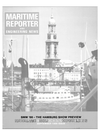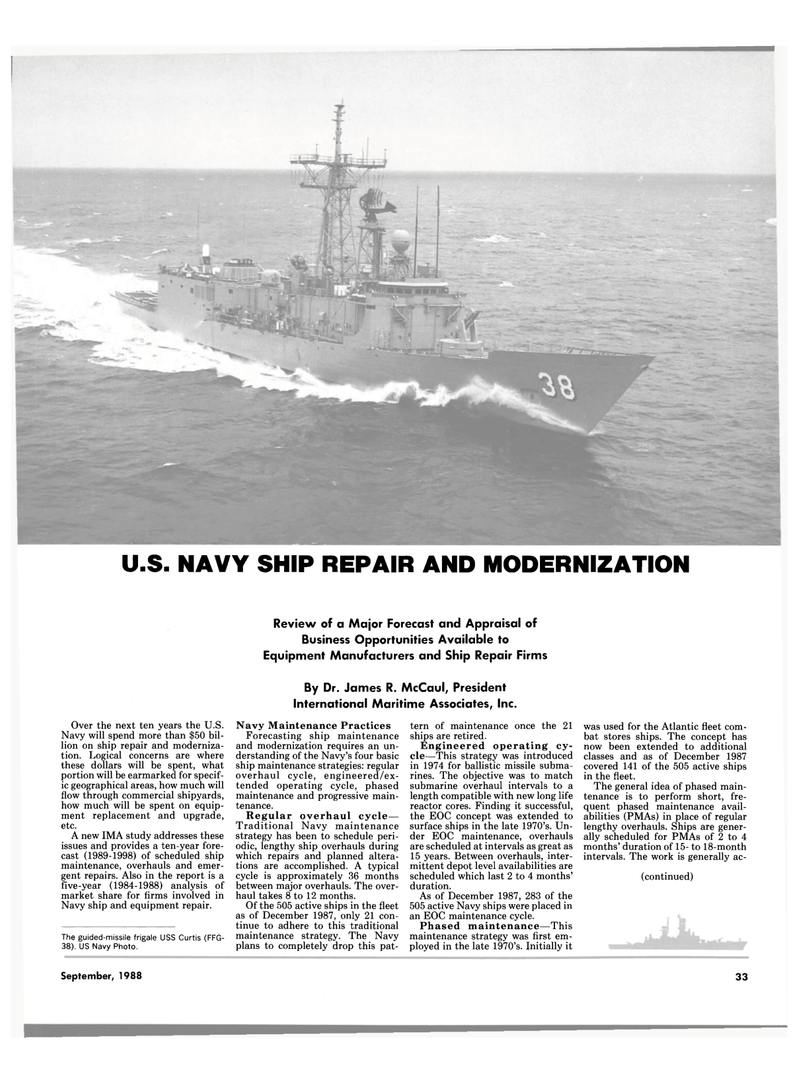
Page 27: of Maritime Reporter Magazine (September 1988)
Read this page in Pdf, Flash or Html5 edition of September 1988 Maritime Reporter Magazine
U.S. NAVY SHIP REPAIR AND MODERNIZATION
Review of a Major Forecast and Appraisal of
Business Opportunities Available to
Equipment Manufacturers and Ship Repair Firms
By Dr. James R. McCaul, President
International Maritime Associates, Inc.
Over the next ten years the U.S.
Navy will spend more than $50 bil- lion on ship repair and moderniza- tion. Logical concerns are where these dollars will be spent, what portion will be earmarked for specif- ic geographical areas, how much will flow through commercial shipyards, how much will be spent on equip- ment replacement and upgrade, etc.
A new IMA study addresses these issues and provides a ten-year fore- cast (1989-1998) of scheduled ship maintenance, overhauls and emer- gent repairs. Also in the report is a five-year (1984-1988) analysis of market share for firms involved in
Navy ship and equipment repair.
The guided-missile frigale USS Curtis (FFG- 38). US Navy Photo.
Navy Maintenance Practices
Forecasting ship maintenance and modernization requires an un- derstanding of the Navy's four basic ship maintenance strategies: regular overhaul cycle, engineered/ex- tended operating cycle, phased maintenance and progressive main- tenance.
Regular overhaul cycle—
Traditional Navy maintenance strategy has been to schedule peri- odic, lengthy ship overhauls during which repairs and planned altera- tions are accomplished. A typical cycle is approximately 36 months between major overhauls. The over- haul takes 8 to 12 months.
Of the 505 active ships in the fleet as of December 1987, only 21 con- tinue to adhere to this traditional maintenance strategy. The Navy plans to completely drop this pat- tern of maintenance once the 21 ships are retired.
Engineered operating cy- cle—This strategy was introduced in 1974 for ballistic missile subma- rines. The objective was to match submarine overhaul intervals to a length compatible with new long life reactor cores. Finding it successful, the EOC concept was extended to surface ships in the late 1970's. Un- der EOC maintenance, overhauls are scheduled at intervals as great as 15 years. Between overhauls, inter- mittent depot level availabilities are scheduled which last 2 to 4 months' duration.
As of December 1987, 283 of the 505 active Navy ships were placed in an EOC maintenance cycle.
Phased maintenance—This maintenance strategy was first em- ployed in the late 1970's. Initially it was used for the Atlantic fleet com- bat stores ships. The concept has now been extended to additional classes and as of December 1987 covered 141 of the 505 active ships in the fleet.
The general idea of phased main- tenance is to perform short, fre- quent phased maintenance avail- abilities (PMAs) in place of regular lengthy overhauls. Ships are gener- ally scheduled for PMAs of 2 to 4 months' duration of 15- to 18-month intervals. The work is generally ac- (continued)
September, 1988 33

 26
26

 28
28
